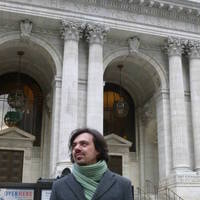
Linda Billings
National Institute of Aerospace, Center for Integrative STEM Education, Director of Science Communication
I am a social scientist with a Ph.D. in mass communication who specializes in science communication, risk communication, and the rhetoric of science.
less
Related Authors
Renzo Taddei
Universidade Federal de São Paulo (UNIFESP)
Simon Werrett
University College London
Naim Kapucu
University of Central Florida
Don Ross
University College Cork
Marko Monteiro
Universidade Estadual de Campinas
Michele A Willson
Curtin University
Adam Burgess
University of Kent
Mirko Canevaro
University of Edinburgh
David Seamon
Kansas State University
Giulia Sissa
Ucla
InterestsView All (11)










Uploads
Papers by Linda Billings
the social construction of the biosphere and its expansion into the solar system, and beyond
This chapter will explore whether and how the scientific search for evidence of extraterrestrial life, in the solar system and beyond, has affected our conception of the terrestrial biosphere – and vice versa – and extended the idea of “biosphere” into outer space.
From my biased perspective, as a long-time member of the astrobiology community, I’m convinced that, of course, the search for life elsewhere has affected the way we think about our home planet. This essay will consider the ways in which this has occurred. While it will not ignore the contributions of space-based Earth observations and human space flight to a change in conceptions of our biosphere, it will focus on the contributions of exobiology and astrobiology, focusing on the search for extraterrestrial life and, to some extent, the search for potentially habitable extrasolar planets (exoplanets).
This chapter is by no means a comprehensive report on space commercialization efforts from 1983-1985, and certainly not a comprehensive report on current commercial space activities. It provides a sampling of proposals and developments reported in SBN from July 1983 to July 1985, and much of the information in this chapter is anecdotal. I will focus on areas of commercial space development that were hot topics at the time, and I will avoid delving into the politics of space commercialization during those years. I will conclude this chapter with some observations and reflections on the status of “space commercialization” in the 2020s.
the social construction of the biosphere and its expansion into the solar system, and beyond
This chapter will explore whether and how the scientific search for evidence of extraterrestrial life, in the solar system and beyond, has affected our conception of the terrestrial biosphere – and vice versa – and extended the idea of “biosphere” into outer space.
From my biased perspective, as a long-time member of the astrobiology community, I’m convinced that, of course, the search for life elsewhere has affected the way we think about our home planet. This essay will consider the ways in which this has occurred. While it will not ignore the contributions of space-based Earth observations and human space flight to a change in conceptions of our biosphere, it will focus on the contributions of exobiology and astrobiology, focusing on the search for extraterrestrial life and, to some extent, the search for potentially habitable extrasolar planets (exoplanets).
This chapter is by no means a comprehensive report on space commercialization efforts from 1983-1985, and certainly not a comprehensive report on current commercial space activities. It provides a sampling of proposals and developments reported in SBN from July 1983 to July 1985, and much of the information in this chapter is anecdotal. I will focus on areas of commercial space development that were hot topics at the time, and I will avoid delving into the politics of space commercialization during those years. I will conclude this chapter with some observations and reflections on the status of “space commercialization” in the 2020s.
The author’s position is no. It should not be done.